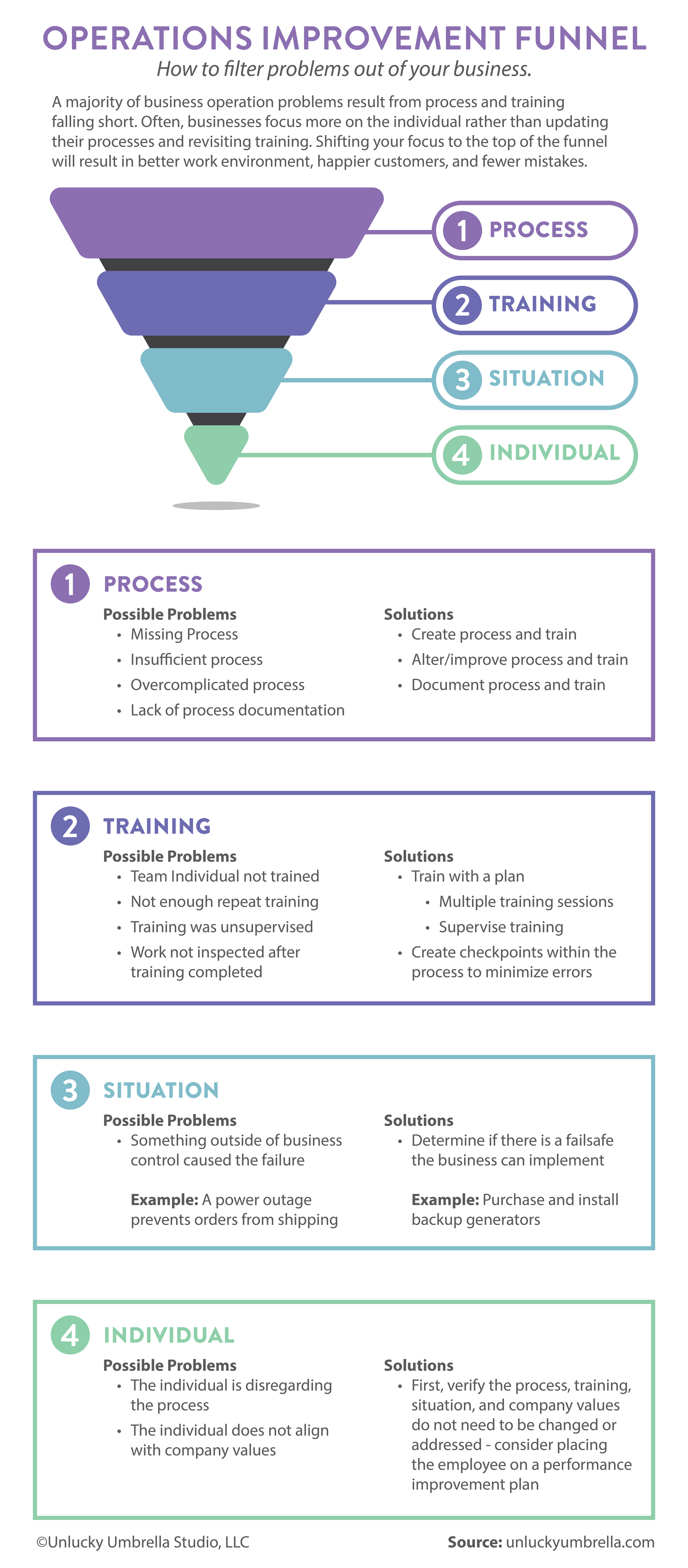Operations Improvement Funnel: How to filter problems out of your business.
More Writing
Author: Kasandra Murray
As the owner of Unlucky Umbrella Studio, Kasandra focuses on the importance of growing marketing and operations together. She has over a decade of experience in management, operations, and marketing. She aims to help businesses resolve critical issues and increase revenue, which leads to happier clients and a better work culture.
My employees keep making mistakes. What should I do?
We are all human and capable of mistakes. It's critical to find the root cause of errors before reprimanding employees. From our experience, more than 90% of business operation problems result from process and training issues. Often, businesses focus more on the individual rather than updating their processes and revisiting training. Shifting your focus to the top of the funnel will result in better work environment and fewer mistakes.
Understanding the stages of the Operations Improvement Funnel.
The funnel contains four stages: Process, Training, Situation, and Individual. Think of the funnel as a filtering process. Always start by feeding problems into the top of the funnel. Ask questions about what caused the problem through each stage of the funnel.
For example, say you run a coffee shop, and an employee mistakes the recipe for a drink, causing a customer to complain. You should ask the employee these questions to find the root cause of the problem.
1. Process
Is there even a recipe for this drink?
Is the recipe written down somewhere easily accessible?
Is the recipe missing information on how to make the drink accurately?
Is the recipe long, cumbersome, or written in a way that makes it hard to read?
2. Training
Has the employee ever been trained on how to make the drink?
Has the employee had a few training sessions around making the drink to ensure they understand the process?
When the employee was learning how to make the drink, were they supervised by an expert to ensure they followed the process accurately?
As the employee gained autonomy, was their work occasionally inspected to ensure accuracy?
3. Situation
Was there something outside the employee's control that caused the problem?
Example: The employee didn't have all the necessary ingredients due to supply shortages.
4. Individual
If the process is accurate, the employee has been trained and retrained, and no situation caused the issue, why is the employee not following the process?
Always Assume Process or Training is The Issue
Former PepsiCo CEO Indra Nooyi said, "Whatever anybody says or does, assume positive intent." Always start by assuming your employee wanted to do the correct thing but likely didn't have the tools needed. Positive intent can transform your company culture and encourage collaboration and employee autonomy. When walking through this funnel, always start by assuming there is a process or training issue. Starting here immediately removes the need for employees or management to get defensive, resulting in a more productive conversation.
Important Notes for Management
A flawed process isn't a reflection of you as a manager.
Processes change frequently. It requires a village to keep them up-to-date; getting employees comfortable with writing processes can take time. If a process you wrote is outdated or complicated for someone with less experience to understand, that doesn't mean you are a lousy manager. It means your process is ready to evolve, and employee feedback is the best way to perfect it.
Always be asking for feedback on processes and training.
When onboarding a new employee, clarify that feedback around processes and training is part of their job. Diversifying your feedback pool will help you create the best processes and training.
Situations can have a solution.
Yes, situations are technically out of your control, but that doesn't mean there isn't a possible solution to help should it ever arise again. Think, for example, of a power outage that caused your business to miss shipments. You could consider getting a generator for this situation going forward.
Training should aim to be multisensory (tactile, auditory, and visual).
Training falls into three major groups: tactile, visual, and auditory. When teaching employees new processes, programs, or equipment, always aim to combine all three. The most important and often least utilized sensory training is tactile. It can be challenging for managers or trainers to release the reins to trainees. If the trainee never touches/does the thing they are learning and only gets to watch you do it, they are losing out on the ability to build and strengthen neural connections.
This doesn't mean you can't start with auditory or visual training first and then move into tactile. For example, if you are training on a dangerous piece of equipment, starting with a demonstration is a good idea, then allow the employee to do it themselves. If what you are training on is not dangerous, nor could it cause detrimental damage to the business, then jump right into tactile training. There is no benefit to keep an employee from actually touching the programs/equipment they are learning.
Here is a breakdown of each type of sensory training and how you can combine them:
Tactile: Physically interacting with equipment or program.
Visual: Images and/or written instructions
Auditory: Lectures
Combining training
Tactile + Visual: Unsupervised training
Auditory + Visual: Demonstration
Auditory + Tactile: Guided training
Auditory + Tactile + Visual: Guided training with instructions
Operations Improvement Funnel InfoGraph.
Here is an infographic you can use to remind you of the steps, problems, and solutions. We have extensive knowledge around training. Contact us today if you want to learn how to implement this within your organization.









You'll want to read about the Operations Improvement Funnel if you struggle to solve problems or help employees make fewer mistakes.